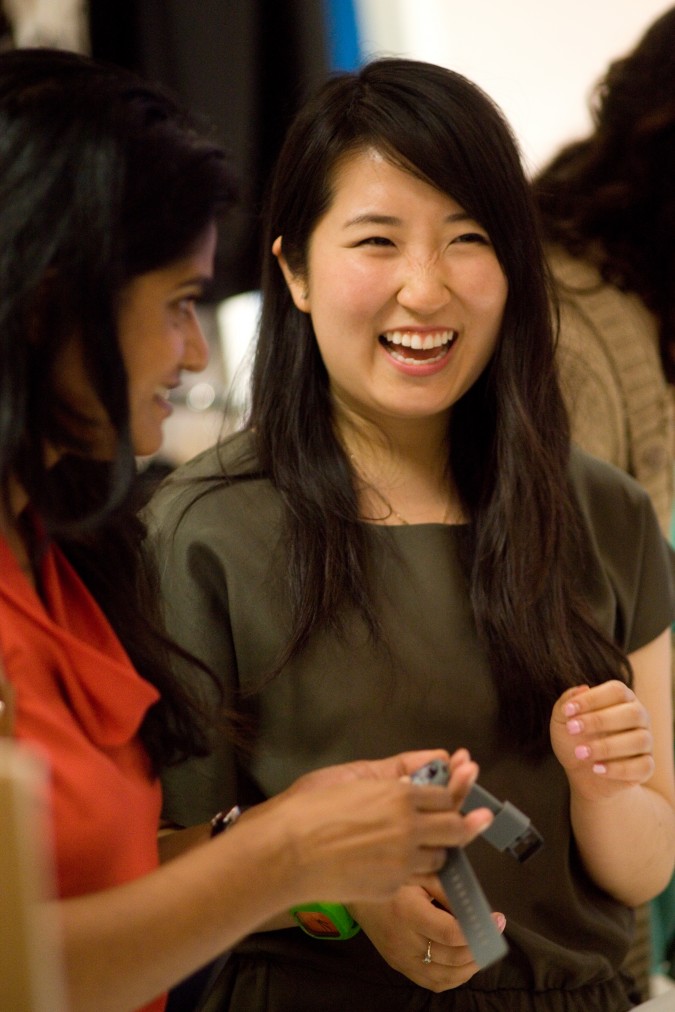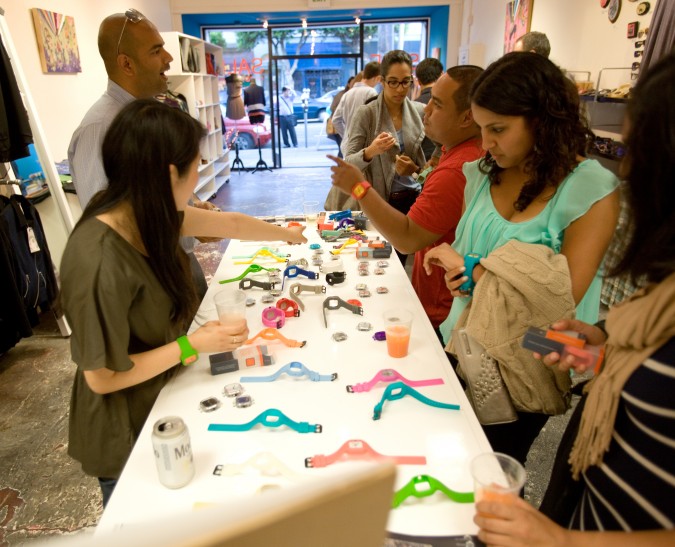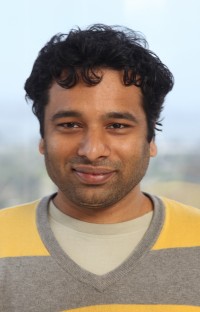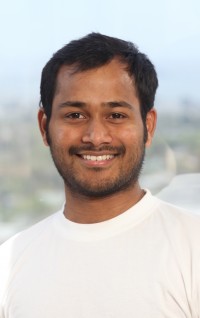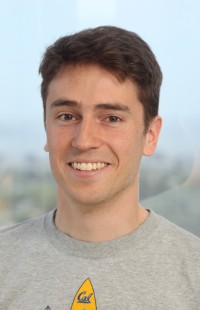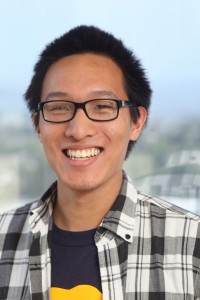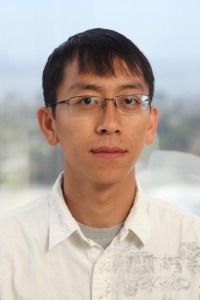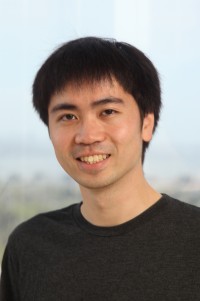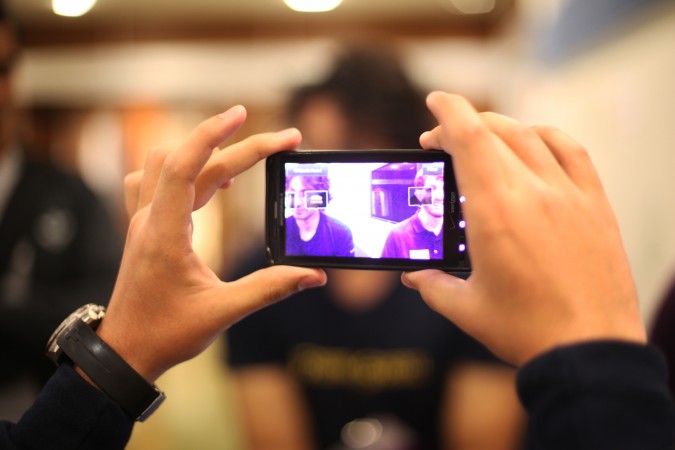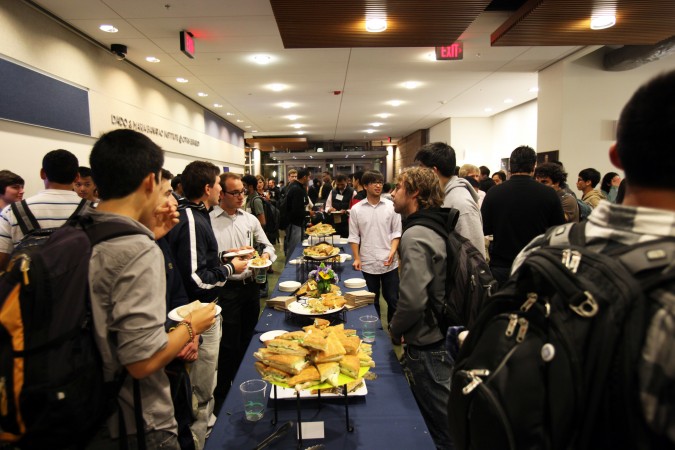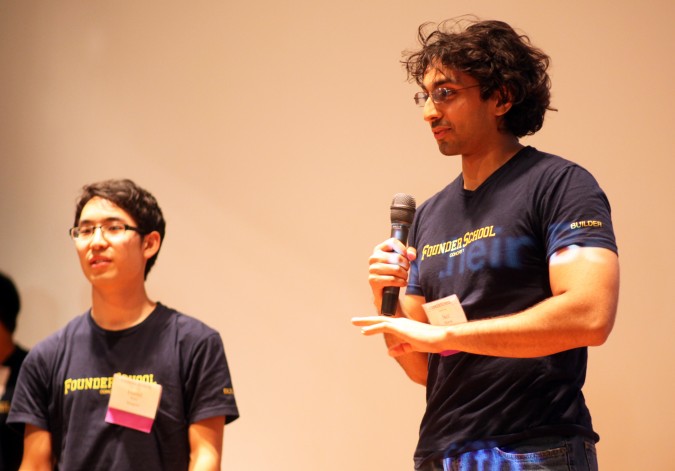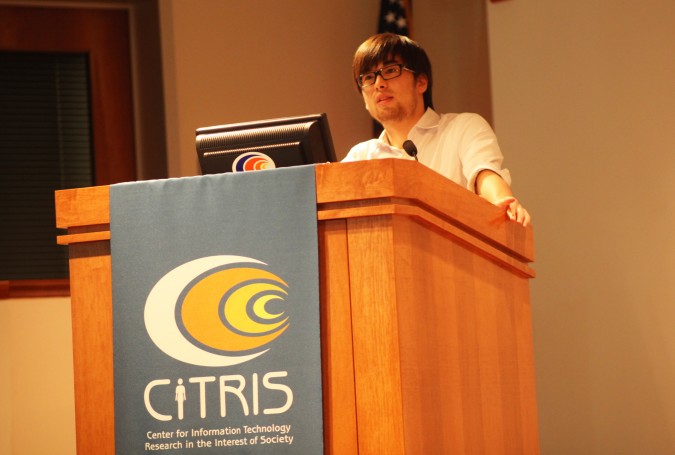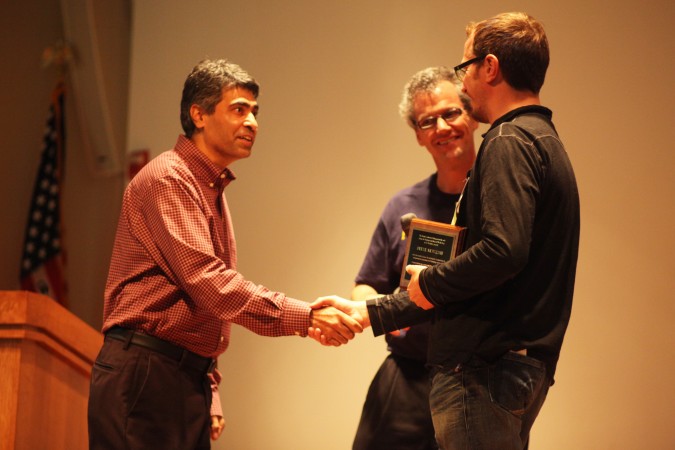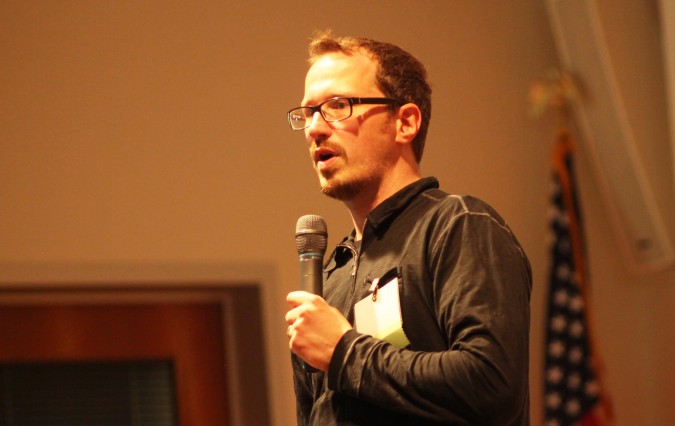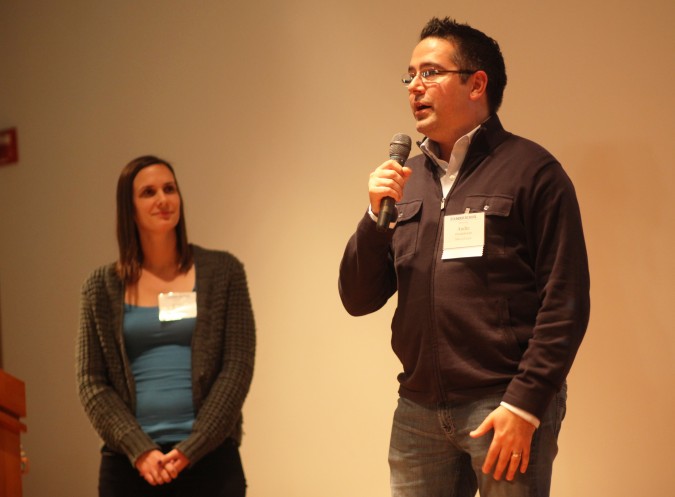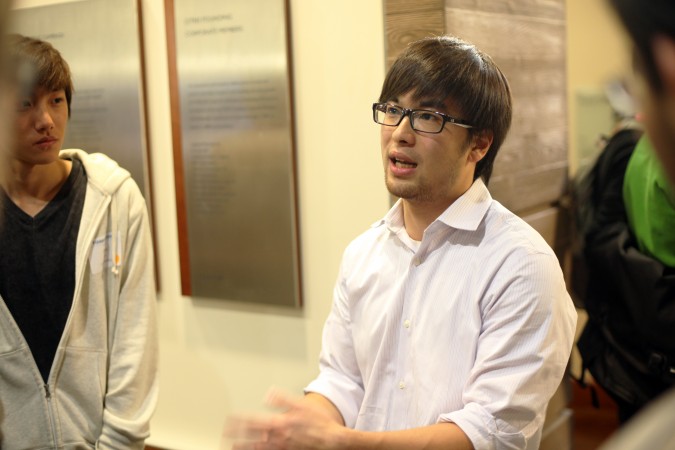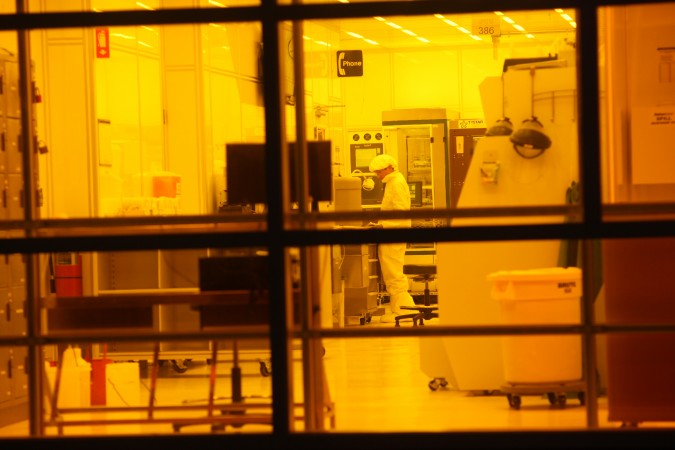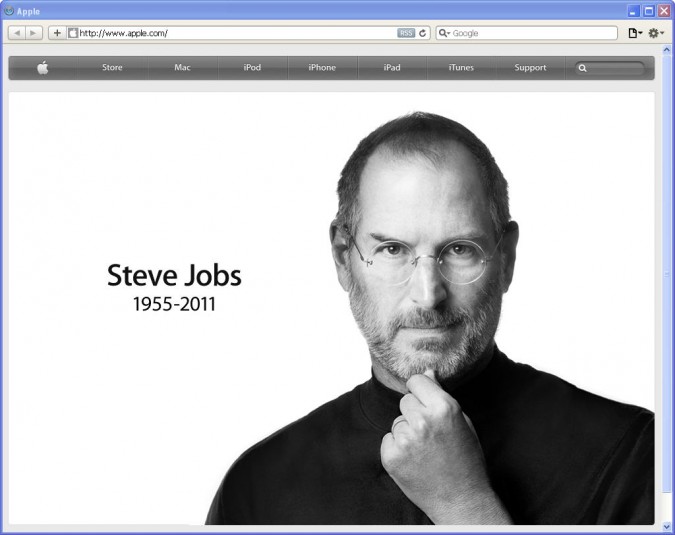Archive for the ‘uc berkeley’ tag
Modify Watches retail launch party at Hangr 16 boutique in San Francisco, California USA, August 9, 2012
On Thursday, August 9, 2012 I attended the retail launch party for Modify Industries, Inc.
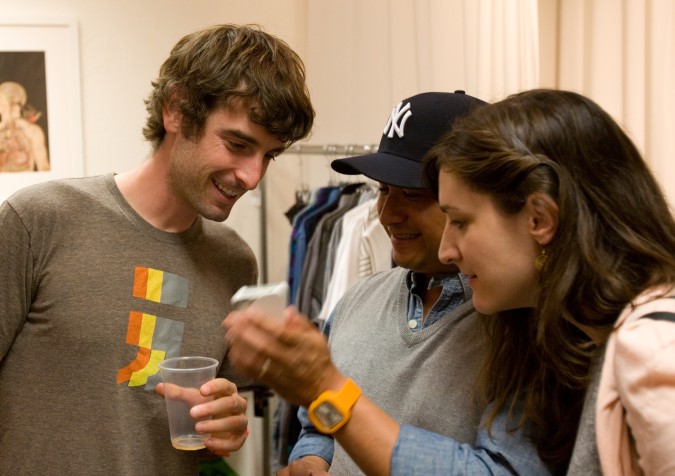
Aaron Schwartz, left, CEO of Modify Watches, checks out an Apple iPhone app August 9, 2012 at Hanger 16 at 3128 16th Street, San Francisco, California USA
Modify Industries is the company behind the colorful and fashionable silicone rubber Modify Watches brand watches that feature time pieces that without tools may be interchanged between bands. You can see people wearing Modify Watches in the top three photographs that illustrate this post. The watches come in two sizes. There are dozens of time pieces and dozens of straps (bands) to select from.
Modify Watches was a finalist competitor in the 2012 Berkeley Startup Competition at the University of California. That competition is very competitive, and it’s very difficult to become a finalist, as there are only eight per year, while most years more than 100 teams apply to compete.
I am friends with Modify CEO Aaron Schwartz.
Click here to see all my blog posts, past and future, that I have written about Modify Watches.
Modify has focused its attention on eCommerce sales and enterprise sales. It has achieved impressive success in both areas, selling to big companies including Google.
Now Modify is moving into retail by selling to boutique retailers.
One such boutique is Hangr 16 at 3128 16th Street in San Francisco, California USA, near Valencia Street. Hangr 16 carries the Modify line of products. The store’s energetic and charismatic buyer, Liddy Parlato, decided to sell Modify’s eye catching line after she opened an email targeted to her store from the company. Parlato told me she gets 30 pitches a day by email. Parlato’s store is spare and elegant, with a well curated selection. It’s not jammed with hundreds of product lines like many boutiques. Thus, Parlato’s decision to carry Modify’s products is a win for Schwartz and his team. Parlato is one of four owners of Hanger 16. She comes from a background in advertising, not retail.
While researching this blog post, I learned that Hangr 16 was voted the Best Clothing Store for Men by readers of the San Francisco Bay Guardian weekly newspaper. That makes the store’s decision to sell Modify Watches all the more special.
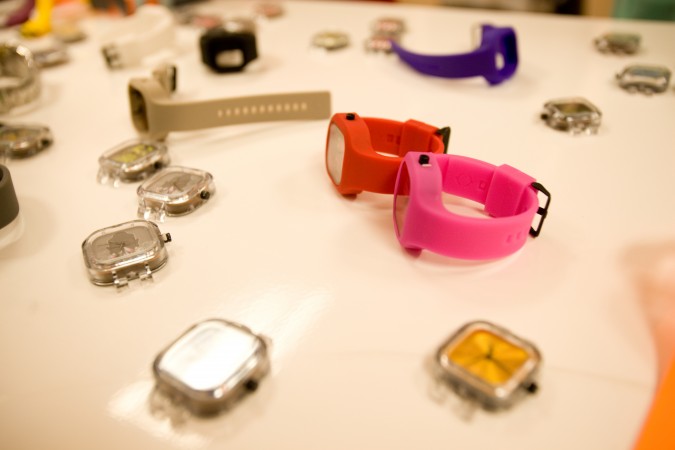
Modify Watches still life at Hanger 16 retail launch event August 9, 2012 at 3128 16th Street San Francisco, California USA
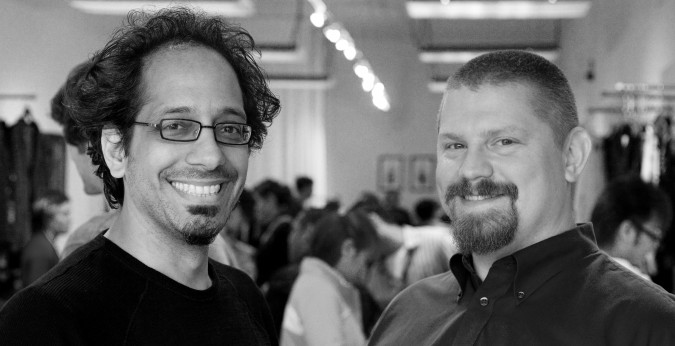
Abie Hadjitarkhani and Nathan Dintenfass, founders of Hotel Delta, at Modify Watches retail launch party, San Francisco, California USA, August 9, 2012
Abie Hadjitarkhani and Nathan Dintenfass attended the launch party. I know Dintenfass from the Haas School of Business at the University of California Berkeley. I met him while he was getting his Masters of Business Administration degree. I participate in many events at Haas to help the students and by extension The Lester Center for Entrepreneurship and Innovation.
Dintenfass and Hadjitarkhani run Hotel Delta, a boutique consultancy that helps entrepreneurs create great products.
Hotel Delta produces the Products are Hard conference.
Nathan Dintenfass is one of the smartest entrepreneurs I know. I have spent hours listening to him advise startups, and his wisdom is evident and deep.
Congratulations to Schwartz and his impressive team at Modify Industries. I predict great things to come.
I took the pictures that accompany this post. I uploaded them at full camera resolution of 21 megapixels. Click on them in delayed succession to see the full size versions, which are larger than your screen.
Legal disclosure — Schwartz let me borrow six of his company’s watches so that I may photograph them being worn by the female models I photograph. I pursue photography as a hobby, and do not charge for my work, so perhaps this disclosure is not legally required. To cover my bases, I am disclosing this loan. I proposed this arrangement, not Schwartz. I would have written this post even if Schwartz did not let me borrow any watches. I will return the watches to Schwartz once I photograph them with some additional models.
I meet the Picatcha.com team at the University of California Berkeley Skydeck startup accelerator
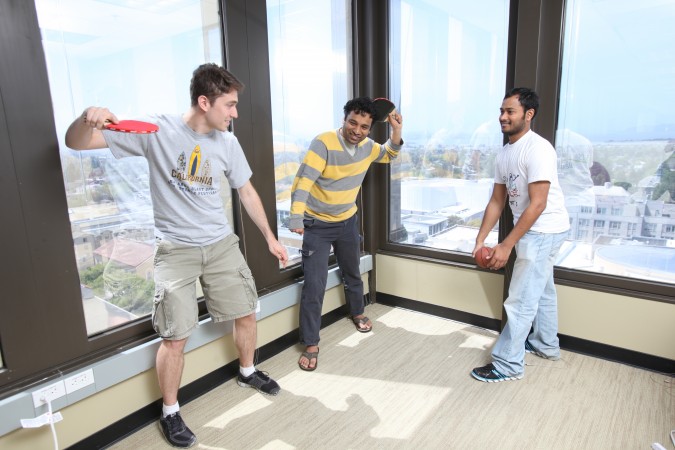
Picatcha.com team playing ping pong with a basketball. May 2, 2012, at University of California Berkeley Skydeck startup accelerator. Photograph by Kevin Warnock.
On May 2, 2012 I met with Satish Polisetti, Dhawal Mujumdar and Sean Carey of Picatcha.
Picatcha is a made up word combining ‘picture’ and ‘Captcha.’
Captcha stands for Computer Automated Public Turing Test to tell Computers and Humans Apart. Captchas were invented by researchers at Carnegie Mellon University.
Even if you don’t recognize the word captcha, you know the test. Here’s an example of Captcha used by Facebook [where I encourage you to subscribe to my posts]:
This Captcha was posted to the photo sharing site Flickr because the first word is difficult to read. You can see Flickr user Chance Abbatoir couldn’t make out the word and wrote wtf? in its place. Wtf is short for ‘what the fuck’ for my readers who aren’t familiar with this slang term.
This illustrates the problem Picatcha is trying to solve.
Regular Captchas similar to the example from Facebook here are too easy for computers to figure out. That allows bad guys to do things they should not do, like buy hot concert tickets as soon as they go on sale, bumping out actual people by overwhelming the websites where the tickets are sold, such as at TicketMaster and Live Nation. The ticket sites assume the buyers are legitimate because the Captchas are correctly deciphered. As a result, more concert goers have to buy their tickets at inflated prices on the secondary market.
In response to such fraud against web properties, traditional Captchas are getting more difficult for humans to solve, such as the one shown here from Facebook. I suspect it says ‘N 1/4’ but I can’t be certain. Can you?
Computers and software are improving. There’s an arms race between conventional Captcha writers and the bad guys. The bad guys are winning.
Picatcha has a different approach.
Picatcha presents a challenge that’s currently difficult for a computer to solve.
The Picatcha twist is that users are asked to look at a set of images and identify the subset that matches a word. For example:
In this example the user has to click on the two middle pictures on the top row, and the second and last picture on the second row. Teaching a computer how to solve this puzzle is much harder than training optical character recognition software to decipher regular Captchas, according to Picatcha. Think about it from the computer’s perspective… the Picatcha way requires machine vision to identify arbitrary objects. OCR only has to deal with 26 letters and 10 digits. A computer trained to break Picatchas would have to handle a vast array of images, which could be crude line drawings up to detailed color photographs.
Picatcha does a lot of other things that make it more compelling than what I’ve so far described.
They allow customers to use images of their products in their picture captchas. Imagine how this would thrill consumer product companies. Imagine how personal this makes the test for users. Suddenly the access tests can become fun, not irritating.
You solve Picatchas by clicking or touching, not typing, making them much more friendly to solve from smart phones and tablets.
There’s extra tricky security happening under the covers, I was told, so this is not a quick programming project to duplicate.
Even more compelling is the Picatcha system can vary the images depending on who the user is. That’s right, the system can tap into your location and demographic data that Picatcha has access to via commercial ad serving services. This strikes me as a brilliant way to enhance user satisfaction and make it more likely they’ll sign up for or buy whatever is behind the Picatcha.
I am impressed with Picatcha. So were the semi-final round judges for the 2011 University of California Berkeley Business Plan Competition, hosted by The Lester Center for Entrepreneurship & Innovation and led by Executive Director André Marquis. Picatcha competed in that competition in 2011 and advanced to the elite final group of eight teams [Note to the Berkeley Business Plan Competition organizers: Keep these links valid in perpetuity. Right now it appears only two years of winners are identified at your site. All winners and finalists back to the 1999 inception of the competition should be listed. Thank you.]. Picatcha collected a cash prize for their efforts. It’s very, very difficult to advance to the finals in that competition… I know as I was a semi-final round judge in that competition. I was not a judge for Picatcha, as I served on the Products & Services track, and Picatcha competed on the Information Technology & Web track. I did not meet the Picatcha team last year at the finals, as I was not yet a tech blogger.
Picatcha started as a school project for Co-Founders Mujumdar and Polisetti when they were students at the School of Information at University of California, Berkeley. They described their work in an attractive summary report. Their Advisor was Bob Glushko.
Picatcha is a hosted service, so its customers don’t need to install any software on their web servers. According to the front page of the Picatcha website today, the company has served up over four million access tests so far, on over 200 customer websites.
When I was meeting with Co-Founder Dhawal Mujumdar last week, he showed me the Picatcha implementation for a brand so famous you are all but certain to have heard of it if you live where their product is sold — M & Ms, the chocolate candy from Mars that melts in your mouth, not on your hands.
Picatcha is sharing office space with other impressive startups at Skydeck, the startup accelerator at University of California at Berkeley, in Berkeley, California USA. I met the Picatcha team after I informed Eliot Sun from Kloudless, Inc. that I’d like him to introduce me to another team, as I had time before my next meeting, and I wanted to be productive. I’ve wrote about Kloudless yesterday, May 7, 2012. I took the pictures for this post. Click on them to see them at full 21 megapixel resolution. There are many more good shots of the Picatcha team playing basketball ping pong in a public album on my Facebook page.
Meet Kloudless.com, a UC Berkeley startup that’s bringing order to your Gmail attachments
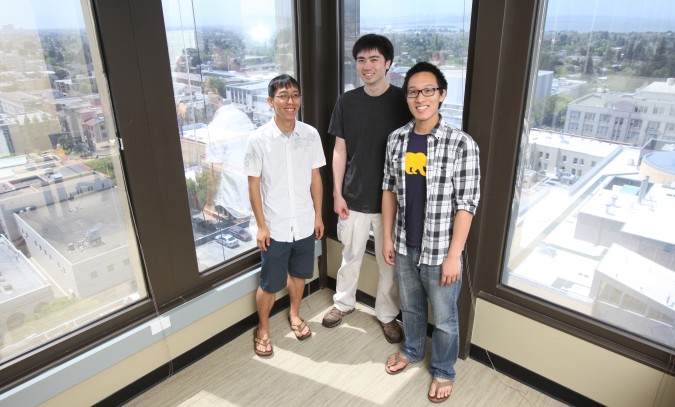
Timothy Liu, Brian Tang and Eliot Sun - three of the four co-founders of Kloudless, Inc., May 2, 2012. Photo by Kevin Warnock.
On Tuesday, May 2, 2012, I met with Eliot Sun, co-founder and CEO at Kloudless, Inc., winner of the IT and Web track at the 2012 Berkeley Startup Competition.
Sun and his three co-founders, Timothy Liu, Brian Tang and Vinod Chandru, have built an impressive productivity utility for use with Gmail, Google’s web based email service. I didn’t get to meet Chandru, which is why he’s not pictured here, as I took all of these pictures. Click on them to see them full size.
Liu, Tang and Sun allowed me to photograph them in their corner cubicle of the University of California Startup Accelerator @Skydeck, commonly referred to around campus as simply Skydeck. Have a look at the sweeping view in the photographs here. That’s San Francisco’s skyline directly behind the heads of Tang and Sun. Click the picture and wait for it to load in a new window. Then click the picture again to see the full size version. You can clearly see the San Francisco Bay Bridge through the glass window.
The Skydeck is located on the penthouse floor of the tallest building in Berkeley, at 2150 Shattuck Avenue, Berkeley, California USA. This building is at the the top of the escalator from the circular exit to the Berkeley BART station.
Kloudless is still in private beta, and I have not personally used the service. But Sun did give me a great demonstration of the working site.
Eliot Sun knew up front that I am a blogger and that I would write this post.
Kloudless is targeted towards users that receive a lot of email with important attachments. Emails that contain attachments fill up email storage far faster than emails without attachments. Search in Gmail does not look inside attachments, according to Sun.
What Kloudless does is hard to believe hasn’t been done before, as it’s brilliant.
Kloudless has a plugin for Gmail that modifies the user’s options. A new option when one receives an email with an attachment is to move the attachment to that user’s account at either DropBox or Box, which are popular cloud storage services offered by two different companies.
If a Kloudless user directs the service to move the attachment file to DropBox or Box, the Kloudless service does so. What makes Kloudless deserving of winning competitions is that it remembers where it put the file. The next time the user views that email in Gmail, they won’t have the attachment directly available to them from Google. However, there will be a link to the file that is now stored in the cloud at either Box or DropBox. A file can be stored at both services at once, if the user so chooses.
Kloudless is storing the association between original email and the stored attachment now in the cloud outside of Google.
There is a screen in Kloudless where users can review all their attachments in a view that omits all the emails that did not have attachments originally. This condensed view is compelling, for its brevity. If a user finds a file they are interested in, that user can click back to the original email message that brought the file to them in the first place.
There’s a lot to like about the Kloudless business model. They are not a cloud storage provider, so they avoid having to store petabytes of data. They’re storing metadata, not attachments. Their own hosting costs should be moderate since they still have to pay for the bandwidth to move files around between Google and the cloud storage providers.
Kloudless is likely to be able to charge for this service, because it gives such useful control and quick access to users.
Users that embrace Kloudless are likely to stay customers forever, because if they quit the service, presumably they will lose their ability to associate their attachments with their emails, which could be painful.
Eliot Sun is a smart guy. He holds degrees in Mathematics and Economics as well as minors in Chinese and Latin, all from UC Berkeley. You don’t frequently find engineers that seriously studied Latin.
Sun’s three co-founders Timothy Liu, Brian Tang and Vinod Chandru also all graduated from UC Berkeley. Liu is CTO, Tang is Chief Scientist and Chandru is Vice President of Engineering.
Sun also had the smarts to get his name as a domain name, which everyone should do if they can. There’s no better beach front real estate for your personal brand than your own name followed by .com.
Global Brain Corporation, a venture capital firm in Japan, invited Sun to attend their annual Global Brian Alliance Forum in December, 2011. Sun spent four days meeting with potential partners and one day at the Forum. Sun’s Kloudless presentation at the Forum was judged the best pitch of the event.
On September 22, 2011, Kloudless won first place in the Plug and Play EXPO at the Plug and Play Tech Center.
Including the IT and Web track at the Berkeley Startup Competition last month, that’s three wins in less than six months, and Kloudless hasn’t even launched yet.
Kloudless is a company to watch.
PS – I posted 16 more shots from my photoshoot with three of the four Kloudless co-founders to my Facebook profile, where you can subscribe to my updates. I had my studio lights with me as I was on my way to a photoshoot with model Annika, from my blog post about AlbertMing, an early adopter of Skydeck’s services that’s since moved to their own office space in Berkeley.
Have an MBA and an idea? Looking for a technical co-founder to build it and join your unfunded startup for equity alone?
One of my highlights each month is serving as a mentor for the Haas Founders group.
Haas Founders is a group for Haas School of Business graduates from the University of California at Berkeley. It’s an invitation only group, but if you graduated from Haas you are quite likely to receive an invitation if you are a founder or co-founder of a startup company.
Another way in is to have a meaningful connection to the Haas School. That’s how I became a member. I have been a judge for the Berkeley Startup Competition from about 2004 through 2011.
Finally, all Haas graduates can buy their way in by agreeing to pay for the food and drinks. This allows service providers like bankers, investors and accountants to attend. Such service providers can meet ambitious startup founders that sometimes turn into clients.
I write the above to introduce you to the Haas Founders meeting. There is a Facebook page and a Twitter account for Haas Founders. Michael Berolzheimer moderates and organizes the Haas Founders meetings. Berolzheimer runs the genesis-stage venture firm Bee Partners which, according to his firm’s web site, pollinates visionary entrepreneurs with financial, human and social capital. Kishore Lakshminarayanan helps Berolzheimer set up the meetings, which take place at different venues each month, in the East Bay, South Bay and San Francisco, California USA. I met Berolzheimer in 2007, before he took on the responsibility for Haas Founders from the previous organizer, Mat Fogarty, CEO of Crowdcast.
Haas Founders has established a group on the professional social networking site Linked In. As of this morning there are 86 members. I believe the group is seeking new members, so if you fit the requirements, please introduce yourself to Michael Berolzheimer.
Haas Founders can be thought of as a board of directors like support group for startup founders, where no issues are off limits for discussion. That makes Haas Founders one of the most compelling meetings I’ve had the good fortune to attend.
I have attended the Haas Founders meetings since about 2005. Individual meetings are limited to 20 attendees.
This open forum for frank talk is made possible because attendees are asked to keep the the conversations confidential. To my knowledge, there has never been a meaningful breach of this rule. I think that’s a reflection of the trustworthiness and integrity of Haas students and graduates.
Given this secrecy, how can I write a blog post about Haas Founders?
Well, I am not going to discuss confidential information. The advice I am going to give is my own. I gave this advice to a participant at the most recent meeting March 6, 2012 in San Francisco.
I am not breaking confidentiality by repeating what I said that day because I have given this same advice many times without any restriction of confidentiality. It’s already public information. Problem averted. I ran this post by Berolzheimer before publishing it, as I want to be extra careful so as to not be uninvited to future meetings.
I decided to write this post because the issue I am going to talk about comes up so frequently that I have spent hours and hours answering this question over the years.
The question and answer are as follows:
Q: I am a non-technical founder and I have thought of a business idea that requires something technical be built. How do I find a talented technical co-founder to join my company for equity only to build my vision for me?
A: Forget it!
You can’t find a talented technical co-founder to join your unfunded idea stage company for equity only.
There are rare exceptions, but you can not count on them and should not consider counting on them.
One solution is to think of and pursue a business idea that you can implement with only the skills you have already. Here are three companies that I suspect began with little computer programming, for example:
- Become a mushroom farmer.
- Start a fair trade import company.
- Start a men’s fashion manufacturing company.
The smart people I suggest this answer to don’t quickly embrace my advice. That’s understandable. They are in love with their vision and they want to pursue that vision right now. They don’t want to hunt for a technically simpler business idea. They don’t want to learn the technical skills necessary to develop their original idea. They want a savior, a Steve Wozniak, to fall from the sky to do the real work of making a viable product. Usually such non-technical founders also want to reserve more of the company equity for themselves than for this savior, because they thought of the idea. If there is to be an equity disparity, I suggest it be weighted toward the technical contributors who make the product happen, not the non-technical people who think up the idea.
What non technical founders fail to appreciate is that talented technical individuals with the grit to want to start a company are in high demand. They are like supermodels in their desireability. A lot of people are asking them for dates. A lot of these suitors have lots of money to woo them with.
Why would a supermodel date a founder with no money when there is a line of suitors with six, seven or eight figure stacks of money at their side ready to spend?
The answer is supermodels don’t date broke founders.
Supermodels don’t hook up with unfunded MBAs that have a cool idea.
The perhaps sad truth is that MBAs are not held in high regard by many technical experts. This is not a comment on Berkeley MBAs, but on all MBAs. Of course, technical experts desperately need business experts at some point, as exits are rare for companies filled with only technical experts. I am not taking a stand on which type of person is more valuable because they are both vital. What I am saying is the technical people generally perceive that MBAs are not that important. If that’s the perception, then how can an MBA recruit a technical person without money?
There are millions of cool ideas to pursue at any moment. That’s always been the case and that will always be the case.
Talented technical people know they are in demand. They have recruiters calling them telling them so all the time. They read TechCrunch, VentureBeat and GigaOm. They know the technology world is in the middle of a full fledged boom right now. So only 2nd, 3rd, 4th and 5th rate technical people will agree to an equity only founder position with a non-technical sole co-founder.
The only practical exception is if you’ve already been friends with the person for years and they know your work and respect it. So classmates graduating together can get together and start a company, with some founders being non technical and some being technical.
But if you’re looking for a stranger to drop out of the sky to build your vision, you should forget it and focus on finding a simpler idea or on learning the technical skills yourself so you can build the first version of the product by yourself.
Yes, the product won’t likely have to polish of one created by a more seasoned expert, but it can be good enough. You only need it to be good enough to raise money that you can then use to pay a more skilled technical person to make an improved version.
I am not spouting off advice I read somewhere or heard somewhere — I know what I am talking about. Pardon me while I now go into extreme detail to convince you that I do know what I am talking about. What follows may seem like too much, but I have spent dozens and dozens of hours trying to beat this lesson into the heads of very smart non-technical company founders. I feel I need to pull out all the stops here to convince the skeptical that I am right.
I know it’s smart to learn to program because this is what I did to take my startup Hotpaper.com, Inc. from a USD $10,000 investment when I had almost no applicable skills through to a USD $10,000,000+ sale to a public company just six years later.
This is news I’ve written about more than once. But I haven’t described the grueling early work I put in that made this ‘quick success’ possible.
When I started Hotpaper, I was a minicomputer programmer. A Digital Equipment Coporation VAX minicomputer running Open VMS. There was nothing miniature about this computer. It filled an entire raised-floor water-cooled computer room and served 1,000 users in five offices in two US states. I believe it cost more than USD $12,000,000. Back then a 9 gigabyte disk drive cost USD $250,000. I saw the invoices and recall calculating the price per gigabyte.
When I started Hotpaper my only experience programming a PC was writing rudimentary DOS batch files. One can still write these for Windows, to run at a command window prompt. You can do amazing things with batch files, but you can’t write serious client-server or web applications with them. I had to learn to program graphical Microsoft Windows applications, and I had only used DOS on a PC up until that point. I had played for a few hours with a copy of Windows 3.1, but that was the extent of my experience with Windows. The one machine my employer had that ran Windows was so slow (Intel 386 with perhaps 1 megabyte of memory) that when you pressed a letter in a word processor (Ami Pro), there was a lag of about 1 full second before the character would show up on screen. It was pathetic.
I immediately bought a Hewlett Packard Pentium 60 Mhz computer with 4 megabytes of RAM and Windows 3.1 for Workgroups. I added Microsoft Office, which came on 30+ 3 1/2″ floppy disks, not a CD-ROM. This was a Pentium, not a Pentium II, III or IV. In fact, it was the slowest Pentium chip ever sold. But this was the fastest computer I had ever used. I still have it, in storage.
I all but shut myself off from the world for two years with hundreds of dollars of technical books, a 28.8K modem and a telephone. I taught myself to be an event driven computer programmer. Event driven programming is much different from the procedural programming I had done to program the huge VAX system run by my employer at the time, Cooley LLP. Yes, I knew how to program a little bit on a VAX, but Windows is so different that it’s almost as if I was learning to program from scratch.
Thankfully, Microsoft was not yet the market leader in word processing in 1994 since WordPerfect for DOS still dominated, so Microsoft tried very hard to persuade developers to embrace their Word word processing software. They offered free telephone technical support for programming problems, provided you paid for the phone call. There were no unlimited business phone lines back then, so my office phone bill was perhaps USD $100 a month due to all my calls to Microsoft — hours and hours of calls per month. I owe Microsoft so much for those calls, as they helped me to solve every problem I ever encountered. Thank you Microsoft.
Eventually Microsoft overnight switched from free technical support calls to USD $55.00 per incident technical support calls, and I had to stop calling them. But that was a couple of years later, and I had already gotten to be proficient by then, and I could get my questions answered for free on their well run newsgroups. By that point, Word and Office were the market leaders, and they didn’t need to try so hard to make developers embrace their tools.
I worked hard — really, really hard. I worked from about 10am to 10pm Monday through Saturday. On Sunday I wouldn’t come into the office until the mid afternoon, but I would still stay until 10pm or so. I did this from January 1995 through the end of 1996 or so, I believe. It took me that long to learn Windows programming reasonably well.
I didn’t know other software developers. There were no popular coworking spaces. Meetup didn’t exist. I was shy. But I was driven… really, powerfully and passionately driven. I had so little money I was living in a tiny studio apartment on Mason Street near Bush Street in San Francisco, California USA. My rent was USD $625 a month including utilities. I only owned one computer, so I could not work at home. I was at the office a lot, and it was just a seven minute walk to get there. I became really good friends with my office mates the late Stan Pasternak and patent attorney Robert Hill. I have such fond memories of that time.
Was the code I produced great? No. Was it awful? No. Was it reliable? Yes. Was it understandable to others? Yes. Did it get used by others for meaningful projects? Yes. Did I raise money with it? Yes. Did I sell the company successfully by following this model? Yes. Can you do the same? I think so.
At Hotpaper, I had a customer from the day I bought a computer. I told them I could build what they asked for. I actually had never done so on Windows. I had to figure out how to program Windows because I had a paying customer that demanded a Windows client-server based solution. They were paying me thousands so I had to deliver. I didn’t study for two years and then start to look for a client. I got the client based on my past reputation as a VAX programmer and then faked it until I made it.
It turns out that first project failed and the client never used my work or the work of any custom software developer.
They just bought an off the shelf application and conformed to its way of doing things.
But that’s irrelevant in the end. I got paid USD $30,000. I worked hard. The client made the best decision, for they should never have hired me or any developer when an off the shelf package was available for much less than having custom software written. I learned a lot, kept the rights to what I had built but did not get used, and I used that for the basis for what I then turned around and sold to Coca-Cola and the United States Department of Commerce, where it did get used on an enterprise scale.
Today it’s easier than ever to become a programmer. There are so many online tutorials like those from Codecademy. There are so many hacker co-working spaces like Hacker Dojo where you can base your new venture. You can work there as many hours as you can keep your eyes open, and there are smart people around much of the time to get help from.
Today all the software you need to do almost any project is free. That wasn’t the case in 1995, when now standard building blocks like MySQL hadn’t been popularized yet.
I have seen smart graduates spin their wheels for months or years trying to recruit a magical co-founder to build their product. How much better it would be for these people to sit down at Hacker Dojo and focus their considerable brain power on learning to program software directly. Even if the entire result is eventually rewritten later by someone more skilled, they would be better off than if they somehow found the mythical co-founder.
For once you know how to program in any language, you will be able to talk about and think about technical problems far more effectively than you can as a non programmer. It will be far more difficult for people to confuse, mislead or bamboozle you. You will be able to hire better programmers who will respect you more. You will be able to tell programmers what to attempt with more clarity and conviction because you know at least something about their world.
You will have insight into a world that’s richly diverse and totally fascinating. Your life will improve even if you never make a penny from your venture.
Programming is not easy. It can be absurdly complicated and exasperating at times. That’s why new college graduates who know little about the real world of programming can still command pay approaching USD $100,000 to start.
I am just one modestly successful entrepreneur.
Before you become a programmer, ask some technical startup founders you trust and see if they agree with what I’ve written here. Remember, Steve Jobs got lucky with Steve Wozniak. Silicon Valley was a sleepy place back then compared to today. Go make your own luck by developing your technical skills. If you have an MBA, you presumably spent four years to get an undergraduate degree and two years to get a business degree. Spend two more years to become a programmer. Doctors spend more time studying before they complete their education, so view eight years of study as normal, not crazy or silly.
I love programming, and I am extremely grateful I spent those grueling early years just powering through the books and road blocks to learn to program.
I feel I can do nearly anything I can dream up.
That’s a powerful feeling I wouldn’t give up for anything.
Please subscribe to this blog by leaving your email address in the upper right corner. Please friend or subscribe to me on Facebook. Please follow me on Twitter.
Berkeley Startup Competition – please participate
Please participate in the UC Berkeley Startup Competition, formerly known as the UC Berkeley Business Plan Competition. Here’s the email notice I received this morning from the competition organizers. Since this link will eventually not work, I prepared a screen capture of the email and I show it below this paragraph.
My friend Kelly Karns of AutoTB is shown in the picture at the lower right of the email screen capture above. That’s Andre Marquis, the Executive Director of The Lester Center for Entrepreneurship in the lower left. Marquis is shaking things up and making changes — I wrote to him October 5, 2011 suggesting the name of this event be changed to The Berkeley Startup Competition, and today I open my email and the name has been changed. My suggestion may not have been unique, so I am not trying to take all or even a majority of the credit for renaming the premier entrepreneurial competition at Berkeley. But I will take my earned share, however tiny or substantial that turns out to be.
I made the name change suggestion to take the focus off of writing business plans that few will read or pay attention to. Instead, I want the focus to be on creating viable startups that create jobs and change the world. Achieving this goal will require a lot more than a new name, and I hope to be invited to contribute more of my many ideas to help reach this goal.
I was a finalist in this event in 1999 and my success I trace directly to this competition. I am grateful that the rules allowed me to compete. I am grateful the rules still allow me to compete, should I want to start a new company.
I have donated USD $20,000 to the competition since 2000 — I am that grateful.
The Lester Center has extended to me many perks beyond what I technically ‘paid for’ with this $20,000, and I thank them for their extraordinary generosity. For example, I’ve recently concluded a dozen year stint on the Advisory Council of the Berkeley Entrepreneurs Forum. I paid nothing for this membership during this dozen years, despite the Council being a fund raising mechanism for the Lester Center. I enjoyed dozens of fascinating dinners during this period, and I made a lot of smart and interesting friends by my membership, including Jerry Engel, Brian Goncher, Robert Dellenbach, Laura Oliphant, Sam Angus and Tom Kintner and by association his brother Avery Kintner. I will miss these twice yearly dinners, which I never missed unless I was out of California.
I am talking with Marquis to expand and extend my assistance to the competition over the next 14 years. There is so much more I can do to help, and the future looks bright under the stewardship of Andre Marquis and the leadership of the student organizers, who have the responsibility to run and perpetuate the event.
Robert Reich – Class Warfare in America, presented by The Mario Savio Memorial Lecture series at Occupy Cal, November 15, 2011
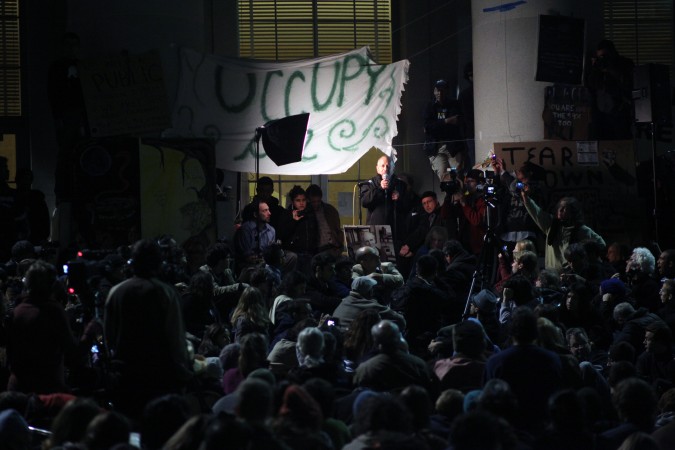
Robert Reich delivering speech 'Class Warfare in America' on Sproul Hall steps at UC Berkeley during Occupy CAL protest on November 15, 2011
I attended the Occupy Cal protest at University of California at Berkeley last evening, November 15, 2011. There were over 1,000 protesters there, including many approaching retirement age that indicated by a show of hands that they had earlier been there protesting in the 1960s and 1970s. It was an electrifying event that I will cover in detail in another blog post.
The event was made more thrilling by a speech given by Robert Reich, a professor of public policy at Cal. Cal is an abbreviation for University of California at Berkeley, for my readers unfamiliar with the word. The definition of Cal is well known locally, but on the world stage UC Berkeley is better known.
Reich was United States Secretary of Labor under President Bill Clinton. Reich is also a frequent commentator on NPR (formerly National Public Radio) in the United States. NPR is my favorite radio station, and I’ve heard Reich speak many times on the air. Last night was the first time I’ve seen him speak.
I brought my tripod and set up my Canon 5D Mark II camera with two of the legs touching one of the Occupy Cal camping tents that had earlier been set up before the steps of Sproul Hall at Sproul Plaza. This was a fantastic vantage point because the tent was already blocking the view of those sitting behind it, so my tripod didn’t appreciably further block the view. I simply sat on the pavement while the camera recorded. I recorded the full speech, and you can watch it in the video below. This is a compressed upload, but I have the full 7 gigabyte file in full HD. If you need the file for some project, please contact me.
Reich’s talk was very well received by the audience, including the tent dwellers sitting right next to me who graciously allowed me to set up there.
It was an inspiring and powerful speech. I am not going to try to summarize it since it’s brief and presented here in its entirety. I encourage you to watch it all the way through, and share it with your social network. I was so taken with it that I stayed up late into the morning editing and compressing the video so I could get this posted today during the day.
UC Berkeley Founder School Demo Day
On October 6, 2011, my birthday, I attended the first Demo Day for the brand new Founder School at the University of California at Berkeley.
Without question, I was exceptionally impressed with the results of Founder School as explained at Demo Day. In fact, I was more impressed with what I learned and saw than I have been by anything else I have ever seen at UC Berkeley.
The only events that can compare for shear impact were two rock concerts I saw years ago — the B52s promoting what I consider their best recording Wild Planet at the Zellerbach Auditorium, and Alanis Morissette promoting Jagged Little Pill at The Greek Theatre.
Yes, I am comparing presenters at a geeky entrepreneur event to actual rock stars, which I’ve never done before.
Founder School was that impressive.
Here’s the video of the event so you can see what I am talking about here:
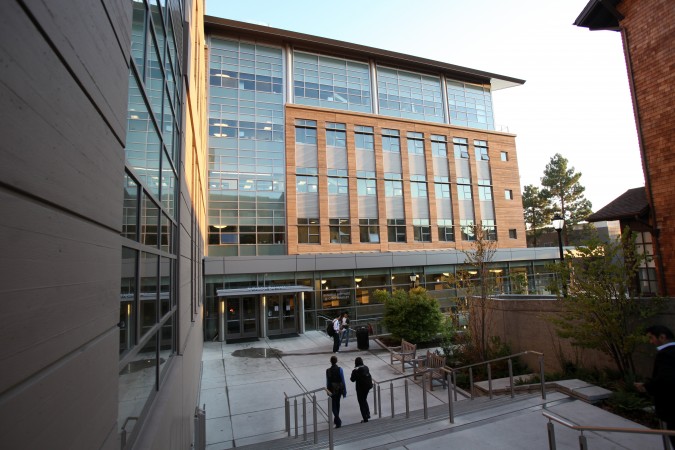
Founder School Demo Day was held at Sutardja Dai Hall at the University of California at Berkeley campus
The website for Founder School does a good job of describing the basics of what it is. But their site doesn’t capture the excitement I felt at Demo Day. What got me so excited?
First and foremost, Founder School is more than even the most ambitious business plan competition. I am a fan of business plan competitions, and have judged three separate competitions at three schools within UC Berkeley over the years. But those competitions are all outclassed by Founder School, because Founder School resulted in three out of the five companies raising USD $3,000,000 before Demo Day. The biggest prize I have ever seen at a university business plan competition is USD $50,000. It’s possible to start a company on well below $50,000, of course. But Founder School companies that raised money raised an average of USD $1,000,000 each during a program that was just ten short weeks. It’s much more possible to start an important company on $1,000,000 because that’s enough to hire paid staff, where $50,000 really isn’t.
The next feature of Founder School is that it’s the first large scale jointly run event sponsored by The Center for Entrepreneurship and Technology (CET) and The Lester Center for Entrepreneurship. The technology I saw as a judge for the business plan competition at the engineering school in about 2006 was more memorable and to my eye more sophisticated than what I usually see at the larger Berkeley Business Plan Competition. I’ve been telling people for years that the engineers need to be incorporated more into the teams for the Business Plan Competition. The Business Plan Competition teams are far too heavily weighted towards MBA candidates, to the decisive detriment of the teams.
Founder School was conceived by serial entrepreneur Steve Newcomb. He approached Jennifer Walske, Director of Social Entrepreneurship at The Lester Center, shown in the picture above. Walske then introduced Newcomb to Andre Marquis, the executive director of The Lester Center. Marquis and Newcomb had a series of meetings, and Ikhlaq Sidhu was brought into the mix. Sidhu is Director of CET, the Center for Entrepreneurship and Technology at UC Berkeley. Newcomb, Marquis and Sidhu worked together to make Founder School happen. From what I can gather, the success of Founder School was a huge group effort, with many more than these three people contributing tremendous effort. I gather that it would never have happened and been successful without the relentless push provided by Newcomb, who has started a sold an impressive series of companies.
Here’s some background on the graduating companies, from the Lester Center website:
Thirst: Building new web and iOS apps that will use proprietary natural language processing technology for social media (think Rapportive or Xobni for Social Media).
Soragora: Augmented reality app allowing users to see the world in a novel way-simply point your phone at any nearby business, restaurant, landmark, or point of interest and learn all about it!
Flotype: Software that lets programmers build massively scalable web applications using Node.JS.
500Friends: Innovative Software-as-a-Service platform that enables leading e-commerce retailers to increase customer retention, acquisition, average order value, and social media engagement by rewarding shoppers not only for purchases but also for brand promotion, product referrals, and creating UGC.
I’m not sure if there were any MBA students on the teams at Founder School, but the staff of The Lester Center was prominently featured and highlighted, so I think in future years more and more mixing of business students with engineering students is likely.
I think that’s key to getting a Google or Apple sized company to come out of the University of California. Are you beginning to understand why I am so ecstatic?

Andre Marquis, Steve Newcomb and Ikhlaq Sidhu. Newcomb showing his award plaque recognizing his contribution to Founder School.
Another great perk provided by Founder School is the access it has arranged for graduating companies to present at SFBeta. For those of you who don’t know it, SFBeta is Bay Area’s ‘finest startup mixer’ according to their website. The founder of SFBeta is Christian Perry, in the green shirt immediately above. Perry invited everyone in the audience to attend as his guest the next SFBeta event on November 8, 2011. For those not in the audience, here’s the link to buy a ticket to attend the November 8, 2011 SFBeta.
Yes, it’s nice to give companies a soapbox on campus to talk about their startup, but the real movers and shakers of the Internet world don’t come to Berkeley to see these pitches. Instead, they’re at events put on by TechCrunch, AlwaysOn and other industry taste makers and pace setters. To my knowledge, no winning teams from any other business plan competition at Berkeley have been awarded guaranteed spots to demo at SFBeta.
I predict that next year the graduates of Founder School will be covered the day after Demo Day by TechCrunch, as it’s likely others have noticed the results this year and won’t miss it next year.
The video above shows the graduating teams describing their startups, and they do it better than I could write about it, so please watch the full video, even though it’s over an hour. It will be an hour that will change your impression of UC Berkeley, I promise.
I introduced myself to Steve Newcomb, the instigator of Founder School. I told him then that what I had just seen was the most impressive thing I had ever seen at UC Berkeley. I’ll say it again here in case he’s reading this.
Founder School is the most impressive thing I have ever seen at the University of California at Berkeley.
I want to help put on Founder School next year. Please let me know how I may contribute.Here’s a short clip of the networking hour and the audience as they’re taking their seats. These scenes are not included in the official video above, but they capture some of the energy and sold out excitement of the event, so I am publishing this clip.
[Note: I am a member of the Advisory Council for the Entrepreneurs Forum at The Lester Center for Entrepreneurship. I am a Venture Coach at CET. I am writing here as an independent blogger, not in any other capacity.]
EGO: UC Berkeley Traditional Korean Drumming (P’ungmul)
On Friday, October 6, 2011, my birthday, I attended Founder School Demo Day on the University of California at Berkeley campus. As I was heading back to the Bay Area Rapid Transit train station, I heard a loud and surprisingly good percussion performance. I followed my ears and discovered the student group named ‘EGO: UC Berkeley Traditional Korean Drumming (P’ungmul).’ Here’s some information on Korean musical instruments.
I had my good camera with me since I took photographs and video at the Founder School Demo Day. I was so impressed with the drumming that I switched lenses to my Nikon 50mm F1.4 lens that I’ve had since college.
I waited for a break and then started capturing video in the extremely low light conditions, since it was about 9pm and the open gathering spot wasn’t illuminated except by sunlight bouncing off the moon and a street light in the distance.
I introduced myself to the students at the conclusion of the piece I recorded. Dan Kong explained that EGO is student group that practices and performs traditional Korean percussion works. I gave him my gOffice business card as I was out of my new blogger cards, having given them all out at the Demo Day.
I explained to the students I am a blogger and that I liked what I heard and saw so much that I planned to write about it and post the video. I made sure they were all OK with that, as I didn’t know for certain if they might be doing something the university might object to, like make a LOT of noise on campus. The students assured me it was fine to post, and they were excited they were about to get some ‘press’, I gathered.
Sadly, I know little about percussion groups or compositions. But I liked what I heard very much. Kong and the other students asked me to mention that they were just practicing, so there were likely to be some errors in their playing. I didn’t detect any errors.
Kong emailed me later that night and provided me with the address to the Facebook page of their group. Here’s a bit of what he had to say to me in his email:
“Sorry about our brief conversation; like I was saying we were practicing for our performance tomorrow and I felt like our conversation may have somewhat been curtailed. I just wanted to provide you with a little bit of info on the piece we were playing, called 사물놀이 (Samulnori which literally translates into “entertainment of four instruments”), and as you may have noticed, there ware four different types of instruments, each representing a weather conditions of: thunder, rain, wind and cloud.”
I captured the video in full HD, but I uploaded it at less than full HD size since I’m running out of space on my main iMac, so I didn’t have room to process the full size file, which was nearly 3 gigabytes.
The video doesn’t capture the impact of this group. I was mesmerized watching them, as they displayed genuine enthusiasm, excitement, and from what I could tell, skill. I hope to see them perform a finished and fully rehearsed piece one day.
Steve Jobs
I saw Steven Paul Jobs in person only a few times, once at Stanford University when he was showing his NeXT computer, once on the floor of NeXTWorld, the tradeshow for NeXT computers, one or more times giving keynotes at MacWorld, and most recently at a Mexican restaurant in Palo Alto, California. The most recent time was about 18 months ago, with my friend and former coworker Hib Engler. Engler pointed out Jobs sitting in the doorway dining area of the restaurant, where burritos sold for about USD $7.00. I couldn’t believe it was Jobs, so I got up and walked out the door, and then back in, passing within a foot of Jobs both times. I was able to look directly at his face, and I am 100% certain it was Jobs.
I was and remain impressed that Jobs ate in such an affordable restaurant.
Steve Jobs passed away today, October 5, 2011. I’m writing this on an iMac. My phone is an iPhone. My laptop is a MacBook. I’m hooked on Apple products, with no regret. Jobs changed my life and changed so much more of the world than one person can dream of.
PS – I had a nice conversation with a woman about Jobs this evening on BART coming home from UC Berkeley where I had a couple of meetings today. I told her about this blog, and if she’s reading this I invite her to friend me on FaceBook or send me a message.
BioLite stove charges cell phone while cooking
This BioLite brand stove produces a tiny amount of electricity that is enough to charge a cell phone or run an LED light.
About five years ago I was a judge for the business plan competition at the Center for Entrepreneurship and Technology at the University of California at Berkeley.
The winning team had a technology that would produce electricity when placed into a flame. Their plan was to sell in the developing world a product for about USD $10.00 that cooks could use to charge their cell phones. I don’t know what became of that company, or if the BioLite stove uses the same technology.
I had a long talk with the founder of the company at Berkeley both before and after the winners were announced. I recall that the technology was developed at Lawrence Berkeley National Laboratory. I was pleased with myself because I predicted this team would win, and they did.
I learned about the BioLite stove on TechCrunch, an AOL blog that covers the technology industry.
